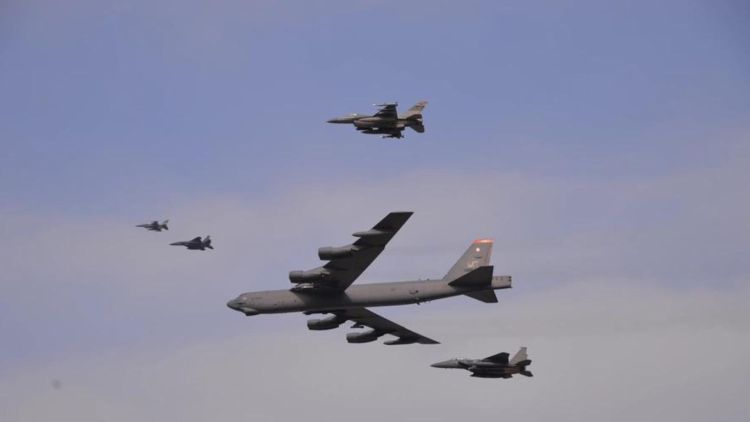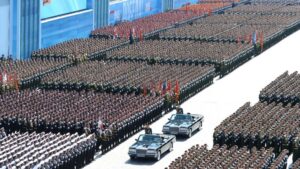Russian jets scrambled to intercept two U.S. Air Force B-52H bombers near the Russian border.
Moscow’s Defense Ministry confirmed the incident, stating that Russian MiG-29 and MiG-31 fighters identified the U.S. bombers closing in after detecting aerial targets over the Barents Sea. This event is part of an ongoing series of aerial encounters between Russia and NATO forces.
The Barents Sea Showdown
The Barents Sea, situated north of Finland, Sweden, Norway, and northwestern Russia, has been a hotspot for military activity. As the Russian fighters approached, the U.S. bombers turned away from the Russian border.
Two U.S. Air Force F-16 Fighting Falcons assigned to 510th Fighter Squadron train in northwest Romania air space March 28-31, 2023. Training along with the Romanian Air Force’s MiG-21 provided a unique opportunity while strengthening NATO partner’s deterrence efforts and interoperability. (Courtesy Photo / DVIDS)
Moscow’s statement emphasized that the Russian aircraft safely returned to their base airfields, conducting the flight under international airspace rules over neutral waters. This adherence to protocols is crucial in preventing accidental escalations.
Routine Interceptions
Russia frequently reports scrambling jets to intercept NATO aircraft nearing its airspace. Earlier this month, Russia detected a Norwegian Air Force P-8A Poseidon patrol aircraft heading for its border on July 10.
In response, a MiG-31 fighter jet was scrambled, causing the Poseidon to turn away from Russian airspace. This is a typical maneuver aimed at ensuring territorial integrity without escalating into a conflict.
In March, a MiG-31 intercepted two U.S. Air Force B-1B bombers over the Barents Sea. Similarly, in September 2023, a MiG-31 encountered a U.S. Navy P-8A approaching Russian airspace in the same region. These incidents highlight the ongoing cat-and-mouse game between Russian and NATO aircraft in the area, reflecting heightened tensions and constant vigilance on both sides.
The Role of B-52H Bombers
The B-52H Stratofortress is a long-range heavy bomber capable of carrying both conventional and nuclear weapons. As part of the U.S. nuclear triad, B-52Hs complement ground-launched intercontinental ballistic missiles and submarine-launched missiles.
In non-nuclear conflicts, these bombers serve various roles, including strategic attacks and close-air support. Their versatility and firepower make them a key component of U.S. military strategy.
In early June, Russia’s military commenced drills in the Barents Sea, involving two nuclear-powered submarines. On June 19, the Russian state news agency Tass reported that the Northern Fleet’s nuclear submarines conducted live missile fire at a sea target in the Barents Sea.
The Northern Fleet, based on the coast of the Murmansk region, plays a crucial role in Russia’s military strategy. These drills are part of Russia’s broader efforts to demonstrate its military capabilities and readiness.
A Continuous Pattern
These interceptions and drills underscore the high-stakes environment in the Barents Sea and surrounding regions. Both Russian and NATO forces remain vigilant, with aircraft frequently testing each other’s airspace boundaries.
The U.S. routinely and visibly demonstrates a commitment to Allies and partners through the global employment of military forces. (U.S. Air Force photo by Tech. Sgt. Delia Martinez / DVIDS)
This ongoing tension reflects the broader geopolitical rivalry between Russia and the Western alliance, necessitating a constant state of readiness and response from both sides.
The situation in the Barents Sea serves as a reminder of the delicate balance of power and the ever-present potential for escalation in these contested airspace.
While these encounters have so far been managed without incident, the proximity of heavily armed military forces always carries risks. Effective communication and adherence to international protocols are essential in maintaining peace and avoiding misunderstandings that could lead to conflict.
Historical Context
This isn’t the first time Russia has responded to perceived threats near its borders. The history of Russian military responses to NATO activities dates back to the Cold War.
Due to its strategic location and significant military assets, the Barents Sea remains a critical area of focus for Russia and NATO. The presence of the Northern Fleet and frequent military exercises underscore the importance Russia places on securing its northern maritime borders.
Similarly, NATO conducts regular patrols and exercises in the region to ensure freedom of navigation and to project power. The interactions between Russian and NATO forces are often tense but are governed by established protocols designed to prevent escalation. These protocols include predefined communication channels and agreed-upon maneuvers to safely manage encounters.
Moving Forward
In conclusion, the recent interception of U.S. bombers by Russian jets is part of a broader pattern of military posturing in the Barents Sea region. Both sides continue to conduct operations that assert their presence and capabilities.
The delicate balance maintained through adherence to international norms and protocols helps prevent these encounters from escalating into conflicts. However, the high stakes and the presence of advanced military hardware on both sides mean that vigilance and careful management of these interactions are essential to maintaining peace and stability in the region.
__
Disclaimer: SOFREP utilizes AI for image generation and article research. Occasionally, it’s like handing a chimpanzee the keys to your liquor cabinet. It’s not always perfect and if a mistake is made, we own up to it full stop. In a world where information comes at us in tidal waves, it is an important tool that helps us sift through the brass for live rounds.



